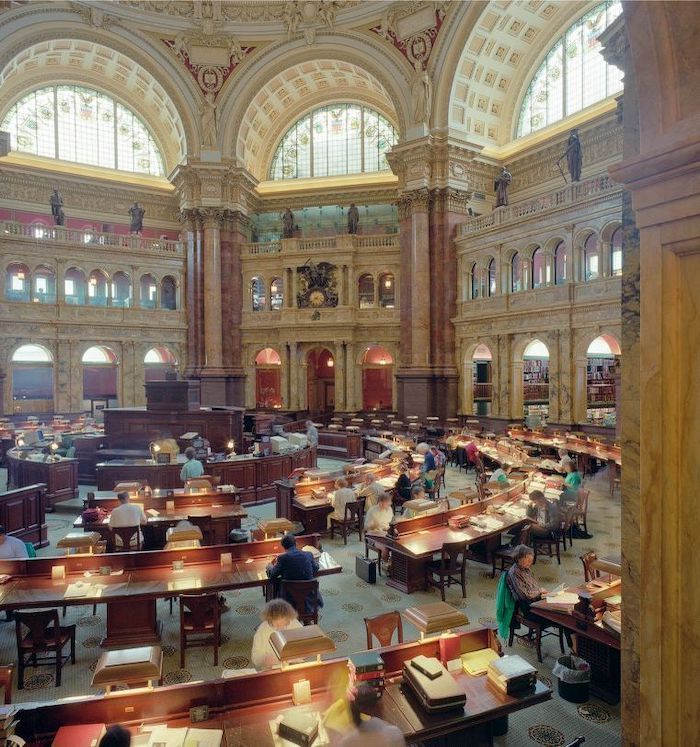Less than a week before Christmas, Herbert Henry’s father has lost his job, and worse, his Christmas cheer. Herbert needs the kind of help only Santa can provide! For a lot of people, that was probably the first time they ever heard that the Library of Congress housed anything besides enough books to stack bookcases side-by-side from DC well across the country. Between the three buildings on Capitol Hill and two offsite storage locations, there are millions of items in their permanent collection. Some of them are on display in exhibits, some preserved in vaults and overseen by specialists in fields ranging from musical instruments to maps to dishes. There are a lot of things you have to visit the Library to see, and even more that you have to get a special readers’ pass to even touch. (Anyone can get one, but you do have to have it before you can utilize the Main Reading Room or any of the other reading rooms.) Across the board, there are so many things in the Library of Congress that it would take one individual hundreds of years to look at each item for a few seconds, so don’t beat yourself up about not knowing about James Madison’s crystal flute. If you do find yourself curious about what other things the Library of Congress has in its attic, here are a few you can check out either in person or in digital exhibits. Some of them are books, and many are not!
Jefferson’s Library
After the original Library of Congress burned with the rest of the Capitol in 1814, Thomas Jefferson (then a private citizen) sold his book collection to the US government. These books formed the foundation of the present Library, and now you can visit the books organized as they might have been at Monticello, in an octagonal layout. (That’s the way it was in his house.)
A Musical Instrument Collection
We’re not just talking about the flute vault, here. They have stringed instruments made by Antonio Stradivari(us), folk instruments from across the world, and a lot of other things that — as the folks at the Library reminded us — are regularly played during their ongoing concert series.
National Jukebox
There’s so much of America’s musical history that has been lost to the modern consumer, because these folks aren’t on Apple Music. You can read up on musicians and musical genres of the past, and listen to some of the recordings that the Library has uploaded into their digital collection. And you can bet, however much we have access to digitally, there’s way more waiting in the wings to be added.
Lomax Family Collection
Okay, yes I’m leaning heavily on America’s music history. It’s particularly cool to dig into the history and work of Alan Lomax, because he recorded so much of the folk music across the country that would evolve into popular music, much of it from Southern Black folks.
A Gutenberg Bible
A lot of people like to say thee Gutenberg Bible, but there were over 100 printed in the first run. The one at the Library of Congress is one of the rare ones left that was completely printed on Vellum, and that is whole. (My Alma Mater had two leaves from one and the archivists were ready to break your hand if you even breathed within a foot of them.)
Rosa Parks In Her Own Words
Does this even need description? This digital exhibit is a great addition to the experience of watching one of the multiple Rosa Parks documentaries currently available. You can read some of her words, see her photographs, and experience her life with her own stuff.
The Main Reading Room
Okay, I realize this isn’t technically part of the collection, but the Main Reading Room in the Jefferson Building of the Library of Congress is one of my favorite places. If you are in DC or are planning to visit, take the tour that will let you look down upon the researchers from the top level. There’s lots of interesting artwork and sculpture that you can see better from up there. And if you get a reader card (and have a purpose for utilizing the reading room) you can set up shop and start requesting books. Every reading room in the Jefferson Building is gorgeous, but this one is majestic. As I mentioned before, there are literally millions of items at the Library of Congress, many of which are books that are excellent for any kind of research, and many of which are photos, manuscripts, film, and ephemera. While the space is a repository of information about the history of the United States and the whole world, the most important thing about information is that it’s disseminated. And the most important thing about flutes is that they get played.

